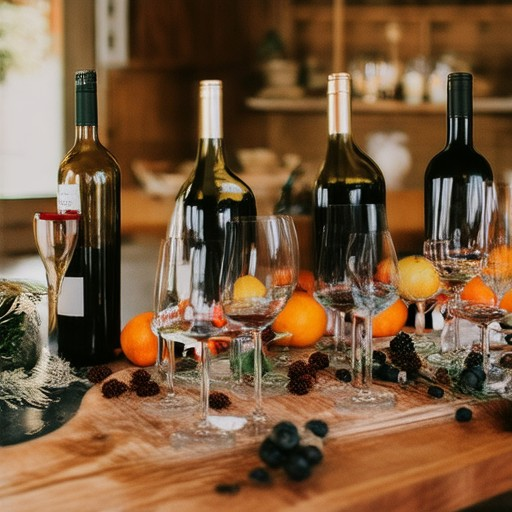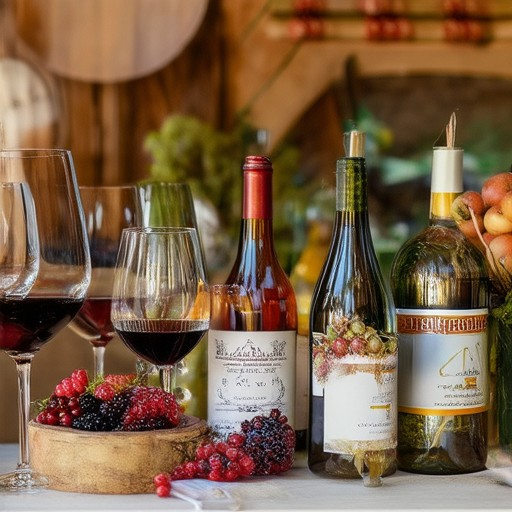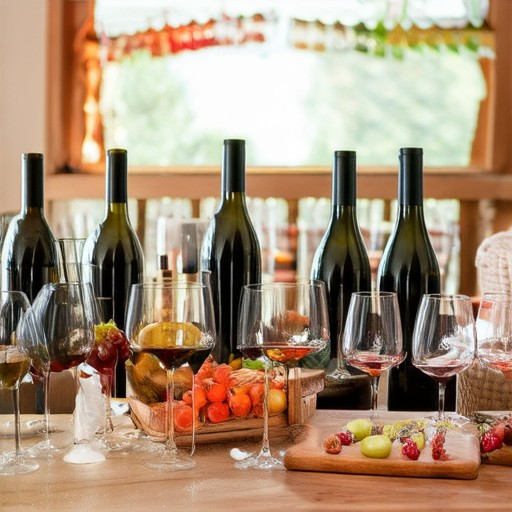Unleash your inner sommelier and transform your home into a chic venue for an unforgettable DIY wine tasting party. Whether you’re planning a casual get-together with friends or a sophisticated soirée, a wine tasting party at home offers a unique and immersive experience that combines flavors, culture, and connection. From setting up the perfect ambiance to curating a curated selection of wines, this guide will walk you through everything you need to know to host a memorable event. Discover how to create a cozy environment, explore creative ways to showcase your wines, and learn the secrets to pairing delicious foods with the perfect vintages. With expert tips and practical advice, you’ll be equipped to throw a wine tasting party that your guests will never forget.
Key Takeaways
– Essential Items for Success: Bring breadsticks, nuts, dried fruits, artisanal cheeses, cured meats, charcuterie, water, and light appetizers like bruschetta to enhance flavor and keep guests hydrated.
– Strategic Pairings: Pair red wines with charcuterie, cheeses, and pâté, while white wines complement nuts, marinated olives, and fruit skewers.
– Wine Quantity Planning: Aim for 12-18 bottles for 12 guests, offering a variety of red, white, sparkling, and dessert wines.
– Logistics Tips: Keep selections light, avoid overpowering scents, and present snacks attractively to ensure a smooth and enjoyable setup.
– Unique Options for Memorable Experiences: Offer stuffed mushrooms, ceviche, or sushi for seafood lovers and diverse texture combinations.
– Flavor Balance: Use antipasto skewers and honey-drizzled fruits to blend sweet, savory, and crunchy elements.
– Practical Advice: Start with lighter wines, mix old and new vintages, and plan 15-20 bottles for buffer stock to accommodate spills and refills.

How to Do a Fun Wine Tasting at Home
Hosting a wine tasting at home can be a delightful and engaging experience. Here’s a step-by-step guide to ensure your event is both enjoyable and memorable:
- Set the Tone:** Create a relaxing atmosphere by dimming the lights, playing soft music, or setting up a cozy ambiance with candles and dim lighting.
- Prepare Your Space:** Designate a specific area for the tasting, such as your dining table or a dedicated room. Set up a central station for glasses and wine accessories.
- Gather Your Tools:** Essential items include:
- wine glasses for each participant
- small plates or snacks like cheese, crackers, and fresh fruits
- white paper or spit cups for tasting
- cork screws or wine openers
- numbered cards for each wine
- a timer or clock for guided tastings
- Serve the Wines Blind:** Present each wine in a blind manner, either by covering the bottle or placing it in a brown bag. This adds an element of surprise and fun.
- Number the Wines:** Assign each wine a unique number or description, such as “Wine 1: Oak Aged Red” to avoid bias and encourage genuine tasting notes.
- Remove Capsules and Hides:** Carefully remove wine capsules and hide corks to prevent participants from peeking, ensuring an equal playing field.
- Guide the Tasting Process:**
- Introduction: Start with an icebreaker question or activity to warm up the group, such as sharing their favorite wine regions.
- Guided Tasting: Use a timer to allocate 30 seconds per wine for sniffing and 60 seconds for discussion. Encourage participants to share their thoughts aloud.
- Feedback and Discussion: After each wine, discuss the aromas, flavors, and textures. Share your own observations and engage in group discussions.
- Add Fun Elements:**
- Play wine-related games or trivia during breaks
- Include themed decorations or music
- Pair wines with complementary foods
- Conclude the Tasting:** End with a recap of the favorite wines and a final toast. Consider sending guests home with a small takeaway, such as a wine-related gift or a personalized note.
By following these steps, you can host a fun and educational wine tasting at home that your guests will always remember. Explore more wine tasting tips and expert insights on Fine Vines , your go-to resource for wine education and events.
How to Host a Home Wine Tasting Party
To host a successful home wine tasting party, follow these organized steps:
- Plan and Prepare
- Select Date and Time : Choose a date that works for everyone and pick a time in the evening when people are likely to be relaxed.
- Set a Theme : Decide on a theme, whether it’s a specific region, varietal, or decade of wines.
- Create Invitations : Send out personalized invites via email or social media, asking guests to bring a bottle of wine or a designated driver.
- Gather Supplies
- Wine Glasses : Ensure you have enough clean glasses for each attendee.
- Tasting Tools : Provide spit cups, napkins, and water bottles.
- Snacks and Pairings : Offer light appetizers like cheese, crackers, or charcuterie, and prepare non-alcoholic beverages for those who don’t drink.
- Arrange the Space
- Set Up the Room : Place tables for wine displays and seating arrangements. Use candles or dim lighting for ambiance.
- Display Wines : Organize wines by theme or region on a table with labels facing out. Include wine notes or descriptions for guests.
- Welcome Guests
- Greet Attendees : Welcome everyone and introduce the theme. Assign someone as the sommelier to guide the tasting.
- Start the Tasting : Begin with the first wine and encourage guests to share observations.
- Conduct the Tasting
- Discuss Flavors : Lead discussions about aroma, taste, and finish.
- Pair Wines with Snacks : Explore how wines pair with food items provided.
- Sample Wines : Let guests try multiple wines, especially those from the selected theme.
- Clean Up After the Party
- Clear Tables : Remove empty glasses and used utensils.
- Dispose of Waste : Collect recycling and clean up spills promptly.
For a more engaging experience, consider adding a themed decor, live music, or a wine education session. This guide ensures a well-organized and enjoyable event tailored to impress your guests.

How to Host a Blind Wine Tasting Party at Home
Hosting a blind wine tasting party at home can be a unique and memorable experience. Here’s a step-by-step guide to help you organize and enjoy the event:
Ambiance Setup
- Create a cozy and inviting atmosphere by dimming the lights and playing soft background music.
- Set the table with Riedel or similar fine crystal glasses, which are ideal for wine tasting.
- Prepare a variety of snacks and small plates to pair with the wines.
Preparation Steps
- Select a diverse range of wines, including reds, whites, sparklings, and maybe a dessert wine.
- Label each wine glass with a number or color-coded sticker to avoid bias during the tasting.
- Have a selection of wine accessories ready, such as corkscrews, decanters, and wine keys.
The Tasting Process
- Start with the first wine and give guests about 30 seconds to swirl, sniff, and taste.
- After the first round, discuss general impressions and notes about the wine’s aroma, flavor, and texture.
- Repeat the process for each subsequent wine, allowing time for reflection and comparison.
Food Pairing
- Pair each wine with complementary foods, such as cured meats, cheeses, or light appetizers.
- Encourage guests to try combining their favorite foods with each wine to enhance the experience.
Evaluation and Discussion
- At the end of the tasting, discuss which wines stood out and why they performed well.
- Consider blind-tasting results against known wines to gauge accuracy and improve future sessions.
- Conclude the party with a fun toast and a final discussion of the wines tasted.
By following these steps, you’ll create a memorable and educational blind wine tasting experience for your guests. Remember to stay present and fully engage with the wines and each other!

What to Take to a Wine Tasting Party
When attending a wine tasting party, it’s important to prepare appropriately to enhance the experience while maintaining balance. Here’s a curated list of recommended items to bring:
- Breadsticks and Rolls : These are ideal for cleansing the palate between wine sips without overpowering flavors.
- Nuts and Dried Fruits : Almonds, walnuts, cashews, dried apricots, and figs are excellent choices due to their lightweight nature and complementary flavors.
- Cheese Selection : Opt for soft cheeses like Brie or Camembert for their mild taste, which pairs well with various wines.
- Cured Meats : Prosciutto, salami, and other antipasto items are perfect as they are dry and less likely to cause bitterness.
- Charcuterie Board : Include a variety of meats, cheeses, marinated vegetables, and olives for a diverse snacking experience.
- Water : Essential for hydration to fully enjoy the wines without discomfort.
- Appetizers : Consider finger foods like mini quiche or bruschetta for added variety and interest.
Remember to keep the selections light and avoid strong-smelling foods that may interfere with wine aromas. Presentation is key, so arrange snacks on attractive trays or platters for an organized and enjoyable setting.
What Appetizers Go Well with Wine Tasting?
To elevate your wine tasting experience, pair your selections with thoughtfully chosen appetizers that complement the flavors and aromas of the wines. Here’s a curated list of options:
Red Wine Pairings
Red wines typically pair well with bold, hearty, and savory appetizers. Consider these options:- Charcuterie Platter : Prosciutto, salami, chorizo, and Coppola sausage are excellent choices that stand up well to reds.- Artisan Cheeses : Cheddar, Gouda, and Parmesan are versatile and can enhance the mouthfeel of red wines.- Pâté or Terrine : Duck or foie gras pâté offers rich flavors that complement reds like Cabernet Sauvignon or Syrah.
White Wine Pairings
White wines often pair best with lighter, fresh, and acidic foods. Try these options:- Mixed Nuts and Dried Fruits : Almonds, walnuts, and a mix of dried apricots, figs, and dates are perfect for white wines like Chardonnay or Pinot Grigio.- Marinated Olives : Fresh olives with rosemary and fennel add a refreshing contrast to whites.- Fruit Skewers : Strawberries, melon, and kiwi are light and refreshing, complementing wines like Sauvignon Blanc.
Unique and Special Options
For a memorable experience, consider these standout appetizers:- Stuffed Mushrooms : Fill portobello mushrooms with goat cheese, sun-dried tomatoes, and herbs for a flavorful bite.- Tapenade and Bruschetta : Olive tapenade with crusty bread or bruschetta topping offers a Mediterranean flair.- Ceviche or Sushi : Seafood options like ceviche or sushi can be a delightful twist, especially for guests who enjoy lighter fare.
Flavor and Texture Mixes
Combine textures and flavors to create a balanced tasting experience:- Antipasto Skewers : Alternate slices of prosciutto, mozzarella, and basil leaves for a visually appealing and tasty option.- Honey-Drizzled Fruits : Pair sweet notes with a touch of honey or balsamic glaze for a complementary contrast.
By selecting a variety of these appetizers, you ensure that every guest finds something to enjoy, whether they prefer something crunchy, creamy, savory, or sweet. This diversity enhances the overall experience and keeps the conversation flowing during your wine tasting event.

How Many Wines Do You Need for a Wine Tasting Party?
To host a successful wine tasting party, it’s essential to plan the wine quantity carefully. Here’s a breakdown:
- Number of Attendees:** For 12 guests, aim for 12-18 bottles of wine. One bottle per person is sufficient, but adding an extra bottle (for a total of 13-19 bottles) allows for flexibility and ensures everyone can enjoy a bit more without running out.
- Types of Wines:** Plan to offer a variety of wines, including white, red, sparkling, and possibly dessert wines. Having 8-10 different wines is a good target, which translates to 8-10 bottles. If you want more options, go for 12 bottles to accommodate a wider selection or duplicates if certain wines are popular.
- Serving Sizes:** Each guest may only need a small pour, so one bottle typically serves 5-6 glasses. This makes managing pours easier and prevents waste.
- Flow and Variety:** Consider starting with lighter wines and progressing to heavier ones. Including a mix of older and newer vintages adds variety to the tasting experience.
- Buffer Stock:** For added safety, plan 15-20 bottles if you want to account for potential spills, refills, or if some guests may want to revisit their favorites.
Remember, the exact number can depend on your preferences and those of your guests. Some hosts prefer fewer wines for a focused experience, while others enjoy a larger selection for exploration. Check with your venue or caterer if there are specific constraints like glassware or space limitations.



0 Comments